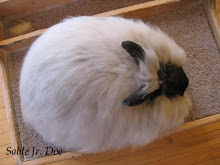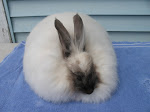Pearl is a color that can either be very dark, or so light that the coat is practically White for all intents and purposes. It is a clear DQ for a Pearl to have pure white body wool, but the standard otherwise describes this variety as having the "Light or dark marking color of Sable; Black, Blue, Chocolate, or Lilac, on-nose or mask, ears, feet, and tail, shading rapidly to a pearl or very light color. Undercolor to be white". According to the Rabbit Genetics list and other books I have read the 'ideal' Pearl is considered to be the very light but not-quite-white version. In my own barn, I have always favored the heavily shaded Pearls with lots of ticking and clear demarcations in the nestbox.
There have been both very lightly shaded Pearls and very dark bunnies born here this spring:). Today I made a project out of trying to photograph some, but as you can see most of the pictures did not come out clearly, though you can still see the markings I was referring to (I think my camera may be starting to bite the dust in today's entry, but it will have to survive a little longer, LOL).
These first two pictures are of some very well-marked Pearls in Echo and Pierre's litter. Even though the picture is blurry you can still see that there are lines of obvious shading on the side of each baby in addition to the normal mask and ear color (much like a good Tort, which is essentially a 'Reverse Pearl':)). The very lightly marked Pearls that are sometimes born do not have these demarcations, just the mask/ear color only. Without exception they all develop into adults that are showable under the standard, but who do not display the kind of shading and ticking that is evident on these babies below, who will grow up to be much darker and more heavily 'marked'.

This next picture below is of one of the babies out of Sadako and Pierre's last litter (age 6 weeks), who is NOT heavily shaded. Unfortunately the marks that are so easy to see in the nestbox tend to get more and more difficult to see once the wool begins to grow in. At this point even a good photograph would have difficulty exposing the difference, though it is still clear with the naked eye in good light during the day. This baby has shading only on the face and ears for the most part, but it is still perfectly showable. The baby BELOW it is a Pearl out of Neva and Dijon's litter who had very discernible shading from the beginning, and even today is basically 'frosted' with Sable tips from head to toe:

(Note: These babies are not posed on a grooming table, but given the temperatures today it wasn't a good idea to move anyone without a compelling reason, so all were snapped in-house instead:)).
In the previous entry where I posted pictures of my older Juniors there were also examples of 'light' and 'dark' Pearls. Spang's D'Artagnan was a very dark color as a baby and continues to have deep shading, while Spang's Savarna was very light, as is evidenced by her present wool color.
These are just a few observations about the color Pearl in Angoras. Once my Sable/Pearl line is established I will probably begin routinely selecting for dark shading in this color. While 'Pointed' could theoretically become too dark in a short haired rabbit, the fact that Angoras elongate their color can give us a great deal of leeway in determining how deep it could actually go in a long-haired rabbit (IMO). Although I do not spin, I imagine that the richest yarn would also result from the darkest rabbit, so it seems like a desirable trait to breed for.
More again next time as we wait for the temps and humidity to go down (soon, I hope) and two more litters to pop up out of Oomi and Evariste, due July 1 & 2.
Have a great weekend!:-)

























No comments:
Post a Comment